Somewhere in your attic, there lives a furry creature with large ears and sharp teeth. They are the only mammals capable of sustained flight with their wings and thin skin, and they are called patagium. Obviously, I am describing a bat. Bats are important in our ecosystem, but not in your house. They act as a natural pest controller by consuming vast quantities of insects. However, when they decide to turn your home into theirs, they become a nuisance and a health concern. In this blog, I will discuss the crucial and delicate process of bat removal, using safe and humane methods to ensure that bats are relocated without harm while solving the issues related to bat guano and structural damage. I will also share some exclusion equipment best suited for bats and other wildlife.
Importance of Bat Removal
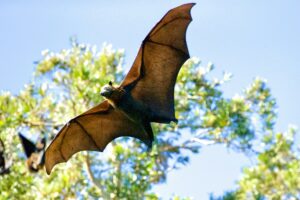
There might be some of you who think that seeing one bat or two or hearing them from your attic can’t be a big problem. This blog is a reminder that it’s not. Bats can pose a serious threat to the safety of your home. Here are the reasons why:
- Disease Transmission – Bats may carry diseases such as rabies, which can be transmitted to humans and pets through bites or scratches. They can be a carrier of histoplasmosis, a fungal infection that affects the lungs, which can be spread through bat droppings (guano).
- Allergies and Respiratory Issues – When bat guano is accumulated, mold growth drastically increases and triggers allergies and respiratory problems in humans.
- Structural Damage – Bats droppings can corrode building materials
- Odor and Stains – The urine of bats and guano can produce strong odors and stains, which can be unpleasant for home residents.
- Ecological Balance – Bats are beneficial for the environment since they control insect populations and pollinate plants. However, they need to be in their natural habitat rather than in homes. Removal should be done humanely to ensure they are relocated safely and continue to help our ecosystem.
- Nuisance Reduction – Bats can live in attics or other parts of your home, which can be a nuisance due to noise.
Understanding Bats in Minnesota
Bats are common in Minnesota for several reasons, including natural habitats. Since Minnesota has a variety of habitats like forests, wetlands, and caves, Bats can find an ideal spot for roosting. Bats also use human-made structures like barns, attics, and bridges for roosting. Insects can be abundant in Minnesota and are the main food source for bats. Moreover, Insects tend to multiply in numbers in warm summers. To reach their summer habitats, Bats tend to migrate to Minnesota. Bats like to stay in caves and mines, which is very common in Minnesota.
Species of Bats Commonly Found in Minnesota
There are species of Bats that are commonly found in Minnesota. Let’s take a look at what these species are.
Little Brown Bat
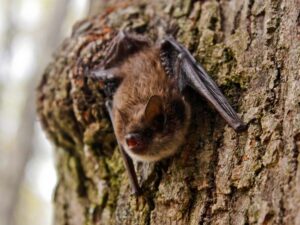
According to the Minnesota Department of Natural Resources, The Little Brown Myotis (Myotis Lucifugus) is widely distributed throughout North America, from Alaska and Canada to Mexico. It is one of Minnesota’s four species of cave-hibernating bats and the most common of the sates’s seven bat species, in secure winter roost sites, where the Little Brown Myotis spends nearly half of each year, which is critical for their survival.
Big Brown Bat
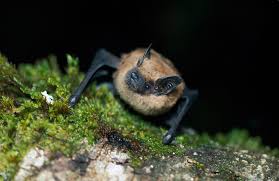
The Big Brown Bat is one of Minnesota’s larger-bodied bat species, with long silky fur on the dorsal side. Their color can vary based on geographic location. In Minnesota, Big Brown Bats are typically chocolate brown on the dorsal side, transitioning to a lighter or olive color on the ventral side. A large head, broad nose, fleshy lips, and larger eyes are characteristic of the Big Brown Bat, making it easy to distinguish from other species in the state. Ears are thick, short, and furred at the base. Exposed membranes on ears, wings, and snout are blackish brown. Size is 8.7-13.8 cm (3.4-5.4 in.) total length. Adults typically weigh 11-23 g (0.39-0.81 oz.) (Kurta and Baker 1990). The size and facial characteristics make the Big Brown Bat easy to distinguish from other bat species in the state.
Northern Long-Eared Bat

The Northern Long-eared Bat closely resembles the Little Brown Myotis but has longer ears, as the name indicates. This increasingly rare bat is highly impacted by WNS and was listed as Federally Threatened in 2014. This species is an obligatory cave hibernator and tends to roost solitarily within the hibernacula.
Northern Long-eared Bats can be found in Minnesota in the winter in natural caves, sand mines, and iron mines. Hibernacula are shared by both sexes and often multiple species of bats. Preferred sites typically have high humidity levels, minimal airflow, and a constant temperature (Fitch and Shump, 1979). After spring emergence, bats migrate to summer roosting and foraging grounds. In summer, the species is often associated with forested habitats.
Bat Behavior and Habits
Like us humans, bats can have their own distinct way of living. Depending on the species, bats can have a specific habitat and ecology. Here are some general characteristics and behaviors you need to know to understand the importance of bat removal better.
Roosting habits

Some of us know this, but Bats live in caves, tree hollows, under bridges, buildings, and foliage. Their choice of roosting site depends on the species and conditions of their habitat. In colonies ranging from a few individuals to millions, rooting in groups helps bats acquire warmth and protection from predators.
Feeding patterns
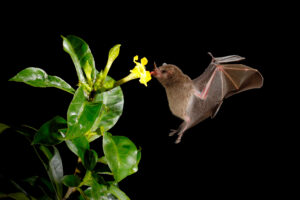
Depending on the species, bats can have varying feeding patterns. Many primarily eat insects, using echolocation to hunt moths, beetles, and other flying insects. Fruit bats, such as flying foxes, feed on fruit, nectar, and flowers. Moreover, some bats, like the false vampire bat, feed on other animals, including small mammals, birds, and other bats. Lastly, vampire bats feed on animals’ blood. They have specialized adaptations for their diet, including heat sensors and anticoagulant saliva.
Seasonal behavior
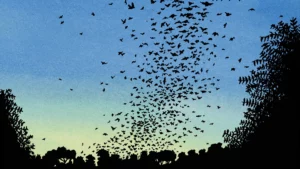
Some bat species migrate on a seasonal basis to look for better grounds for hibernation. Migration distances can be from a few kilometers to over a thousand. In temperate regions, many bats hibernate during the winter to conserve energy when food scarcity occurs. They enter a state of torpor, lowering their metabolic rate and body temperature.
Health Risks Associated with Bats
Why do we want to exclude bats from our property? As discussed in the early part of this blog, we’ve shown how bats can cause fatal diseases.
Rabies from bats
Rabies is a serious life-threatening disease that is completely preventable with proper education and action. According to the Kansas State Veterinary Diagnostic Laboratory, Bats can transmit rabies to humans and animals. Though rabies deaths are uncommon in the United States, it is one of the world’s most deadly diseases, impacting 5 billion people annually and resulting in as many as 70,000 human deaths worldwide each year.
Rabies is transmitted from animals to humans primarily through saliva from a bite of an infected animal. Although additional routes of transmission from animals to humans occur, they are rare. While all mammals can contract and spread rabies, in the U.S., rabies is primarily carried by skunks, bats, raccoons, foxes, and coyotes. Bats are the primary source of human deaths from rabies in the U.S..
Histoplasmosis from bats
According to research by the Louisiana Office of Public Health, Histoplasmosis is a fungal disease contracted through airborne spores in bat droppings. Symptoms may range from mild influenza to blood abnormalities, fever, or even death. An eye condition has been linked to the bat disease histoplasmosis and can lead to blindness in those who contract it.
Legal Protection and Regulations
Minnesota has specific regulations for bat removal to ensure public safety and the protection of bat populations. It is important to take note of these details to avoid possible consequences.
Minnesota state laws regarding bat removal
- In Minnesota, bat removal is restricted during maternity seasons (June 1 – August 15) to protect young bats that cannot fly yet.
- Professional bat removal services may require special permits or licenses from the Minnesota Department of Natural Resources (DNR).
- Non-lethal methods are highly encouraged in exclusion methods, such as exclusion devices that allow bats to leave a building but prevent them from re-entering.
- Killing bats is generally prohibited. The use of pesticides or other harmful chemicals is not allowed.
- Homeowners need to notify local wildlife authorities before initiating bat removal.
- Homeowners are encouraged to seal entry points and implement preventive measures to avoid future infestation.
Federal protections
The Endangered Species Act (ESA) provides federal protection for species listed as endangered or threatened, including certain bat species such as the Indiana bat and the northern long-eared bat. Critical habitats for these endangered bats are protected from destruction or adverse modification, and any federal projects or activities in these areas require an assessment of potential impacts on the habitat.
The ESA prohibits “taking” of listed species, which includes harming, harassing, or killing the bats. Activities that disrupt normal behavior patterns, such as breeding, feeding, or sheltering, are considered harassment and are prohibited. Permits may be issued for activities that might incidentally harm bats, provided a conservation plan is in place. Also, permits for research or conservation activities that benefit bat populations may be granted. Violations of the ESA can result in substantial fines and criminal penalties, including imprisonment.
Other relevant federal laws include the Migratory Bird Treaty Act, which protects certain bat species that migrate across international borders, and the National Environmental Policy Act (NEPA), which requires federal agencies to consider environmental impacts, including effects on protected bat species, before undertaking significant projects.
Signs of Bat Infestation
As a property owner, you should be open to identifying signs of bat infestation. By identifying the existence of bats on your property, you can easily take action and call a professional pest control specialist to solve your bat issue.
Bat droppings (guano)

According to Elite Extermination, bat droppings are generally smaller than mouse or rat droppings and are cylindrical or pellet-shaped. In general, they resemble curved grains of rice with a crumbly appearance. They have an unpleasant, strong, ammonia-like odor that can turn musty as they dry.
Stains or grease marks
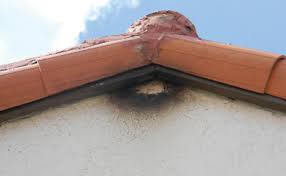
As bats squeeze through their openings, they leave behind a black, greasy stain from resin accumulating on the bat’s skin. These stains will be dark-colored and may wear away at wood over time. Look for dark spots on wood near places where bats might sneak into your home, particularly around frames (Varment Guard, 2023).
Noises
According to Covenant Wildlife, Bats produce high-pitched chirps, squeaks, and flapping sounds. If the noises match these descriptions, bats could be the source.
Exclusion Devices For Bats
Turbine Vent Replacement
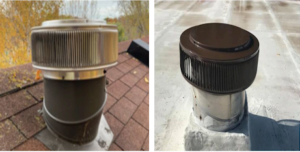
A turbine is installed directly on the top of a roof and uses wind power to suck hot and humid air out of the attic. A turbine has a series of vanes that spin as the wind passes through them, and only basic wildlife proofing in the form of a typical insect screen on the interior.
Abra Kadabra installs animal-proof static vents instead of the existing rotating wind turbines. Standard rotating wind turbines provide ventilation to the attic area but also have large gaps between the fins, allowing wildlife entry.
These replacement static vents provide adequate ventilation with no moving parts and smaller gaps in the louvered fins.
Soffit Junction Exclusion
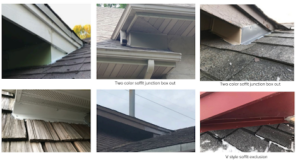
The soffit junction is where the soffit returns to and touches your home’s roof. These areas are not secured during construction, which can allow various wildlife to enter.
Soffit junctions are common entry points for mice, squirrels, birds, and raccoons but can also be used for Bats. We seal with exterior grade 26 gauge metal (the closest color to match). Abra Kadabra technicians will measure, cut, and bend metal to fit in areas where the home’s soffit/fascia is connected to the roofing substrates. Custom fabricated metal pieces will be attached with exterior-grade roofing screws for longevity and bonding.
Gaps at the soffit junction vary in size, length, and substrate material. Proper adhesion to the structure is more difficult with certain roof pitches and substrates; thus, not all soffit junction repairs will be the same. Pricing varies depending on size, shape, substrates, location, pitch, and height.
Gable Vents
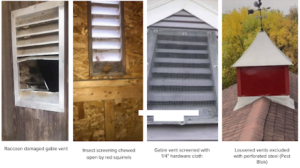
Gable vents are one of the most common entry points wildlife exploit for attic entry. While these vents are often screened from the inside, the lightweight screening material will not stop wildlife from entering the attic. Heavier screens on the inside often result in wildlife damaging the slats/louvers.
In our area, gable vents are free for all wildlife species. Squirrels, birds, raccoons, bats, stinging insects, and mice can readily enter this area through gable vents.
Louvered vents will be custom screened from the outside with a 23 gauge 1/4 inch galvanized wire screen to stop wildlife entry and nesting/roosting of birds and bats. This will also protect the slats/louvers from wildlife damage. The screen will be painted to match as closely as possible to the vent if it is painted.
Ridge vent
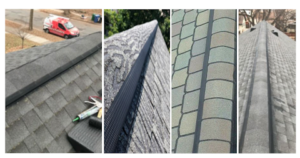
A ridge vent is installed at the sloped roof’s peak, allowing warm, humid air to escape a building’s attic. Roof ridge ventilation is a necessity whenever a roof has asphalt shingling. Asphalt shingles will be compromised prematurely without proper ventilation due to excessive attic temperatures. The shingles would warp and cause potential leaks and animal entrance points. The ridge vent can be readily compromised by mice and bats with almost no effort if the vent is not properly installed. Squirrels and raccoons can damage the shingles and readily intrude into your attic with little effort. If an attic has had wildlife issues, pheromones are left behind. These pheromones appeal to other wildlife and may cause re-entry of wildlife if proper prevention measures are not taken.
The solution is to install a black stainless steel ridge vent protector over the existing ridge ventilation system. This vent cover is made of a 22-gauge expanded metal that has been powder-coated, ensuring years of protection. The screws that are used to secure the Vent covers are self-sealing ¼” drive screws. These are dipped in a waterproof sealant before puncturing the roof to ensure water cannot enter these holes. This product will last as long as your roof. It’s highly effective and barely visible from the ground.
Drip edge
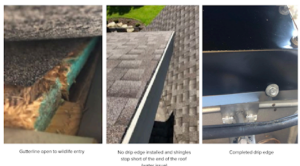
The drip edge is a metal flashing or other overhanging component with an outward projecting lower edge. This is located at the roof’s edge, where the shingles meet the fascia board (or gutterline). The drip edge is intended to control the direction of dripping water and help protect underlying building components. Although the drip edge is unnecessary to meet the Minnesota building code, waterproofing the gutter line is highly recommended. Sealing this area is often forgotten during the exterior construction of the home. This can result in gaps of ½-5 inches.
The drip edge builder’s gap is a common entry point for mice, squirrels, birds, bats, and raccoons. We seal the drip edge builder’s gap with commercial exclusion and exterior building materials. When exclusion is visible, Abra Kadabra technicians will utilize the closest color available to deliver an aesthetically appealing finished product (custom colors are available but will have additional fees associated).
Gaps at the drip edge vary in size, length, and substrate material. Proper wildlife entry prevention through the builder’s gap is completed by utilizing materials such as gutter coil stock, prefabricated drip edge, perforated steel, hardware cloth, chew-resistant backing material, and commercial sealants.
Waterproofing will always be considered when exclusion is completed. Proper adhesion to the structure is more difficult with certain roof pitches, heights of gutter mounts, currently installed gutter guards, types of substrates, and the overall size of the void.
Not all drip edge builder’s gaps will be the same, and voids can vary multiple inches from one structure area to another. Therefore, repairs and materials required to exclude a structure may differ from location to location.
Chimney cap

Chimney caps are protective coverings that go over your chimney’s top, right above the crown. The screening on the sides of chimney caps prevents wildlife entry, while the stainless steel hood prevents wildlife entry and downdrafts of air and water intrusion. Water intrusion poses structural damage issues far greater than wildlife entry.
Uncapped chimneys are a major nesting site for raccoons in the upper Midwest. In addition to raccoons, both birds and squirrels will enter chimneys. These small animals often become trapped, resulting in odors and insect issues.
Abra Kadabra removes any existing chimney cap or mesh. Precise measurements are taken during the inspection to ensure we install a cap that will properly fit your chimney. Securement will be completed according to the manufacturer’s instructions. Stainless steel chimney cap(s) will prevent future wildlife intrusion and come with a lifetime manufacturer’s warranty on materials/ workmanship. Pricing for installation will vary depending on height, pitch, roofing substrates, and other factors.
Control Your Bat Problem With Abra Kadabra
Getting rid of bats begins with a thorough inspection by the team of experts at Abra Kadabra to identify areas where they can enter the home. Once we find those areas, we’ll seal them off to prevent bats from coming inside in the future—we know from experience that they will certainly try!
In high-traffic areas, we’ll install bat valves during the season when they’re most active but not during the season when they’re reproducing. Why? Because we don’t want to end up killing a protected species of bats! Once we install the valves, they’ll stay up for at least three nights, provided the weather is good (no rain, wind, or extreme temperatures) and insects – the bats’ main food source – are active outside. After the valves have been up long enough and the bats have left the home, we’ll bat-proof your home and do the final exclusion work. Then, we’ll return to ensure the bats haven’t found another way inside or set up a roosting site outside where you can be exposed to their droppings. At that point, we’ll give your home the Abra Kadabra seal of approval. But wait – there’s more! Because our pest control technicians are cross-trained on what to look for in terms of bats, they’ll keep an eye out for any areas that might be compromised during their routine service visits. This helps us proactively protect your home and family from future bat issues.

